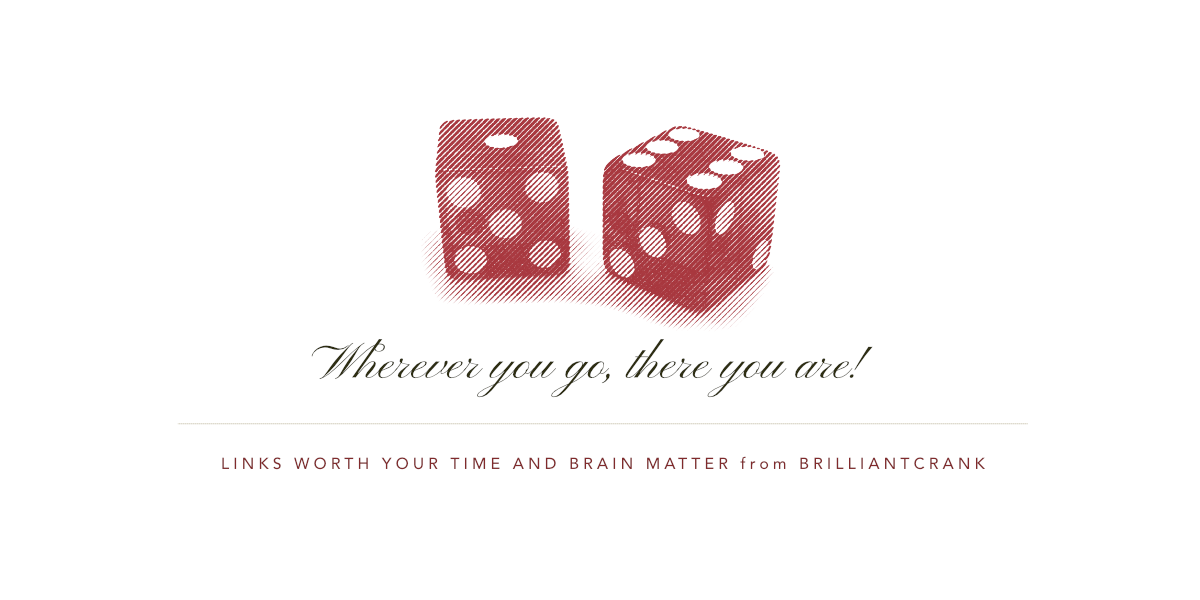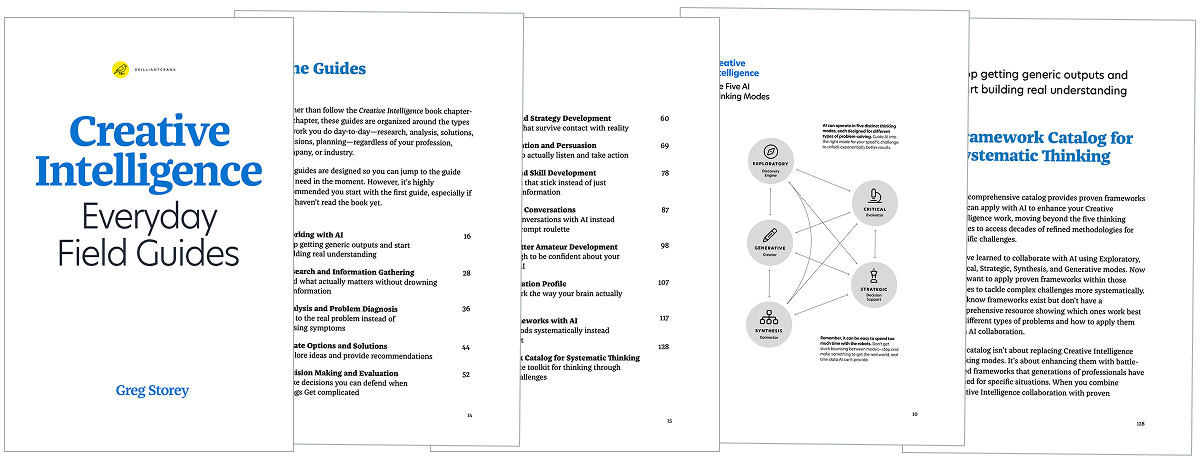The Dice — 039

This has been a big year for expanding my writing through books, zines, and now as a contributing writer to a magazine. Months ago I was asked to republish Eject Disk as the opening act—so to speak—in the debut issue of Geezer, a magazine for Gen X.
My copy arrived this week and it’s so good. Geezer feels like a giant zine in the best possible way. If you grew up in the time of The Breakfast Club, Vuarnets, The Sex Pistols, the Pontiac Fiero, Max Headroom, food courts, the Original Mullet™, and invisible Pepsi, then you need to pick up the first issue.
Meanwhile, last week I promoted the Eject Disk zine collection, but I also quietly released the Everyday Field Guides for Creative Intelligence—see more below.
I’ve got so much more to type out of my brain and get into more publications in 2026. If ever there was a time to submit a request a topic or theme you’d like to see Brilliantcrank address, it’s now.
Enjoy the rolls, and for those who celebrate, Happy Friendsgiving.

This roll is for everyone who has a hard time looking towards the future and not feeling bleak. Could Should Might Don’t by Nick Foster is a book “about the history of the future and the history of the different futures that we have imagined, designed, or projected for ourselves.” I took a course on Future Studies a few years back and one of the key insights is that systems fail but that doesn’t mean they simply collapse. Check out Nick’s book and buck up happy camper. And if that doesn’t do it, then watch these humans imitate chickens.
Be sure to check out the “Go Further resources Things to Watch and Things to Read. But only after you subscribe to Sentiers and Near Future Laboratory who provide a lot of food for thought on the topic of the future.

Seemingly taking a page from Austin Kleon’s Steal Like an Artist, the website Writing Examples is a colorful collection of written passages that “deconstructs a piece of writing from an iconic writer. The goal is to give you X-Ray vision into what makes sentences and paragraphs come alive (so that you can improve at your craft). It’s a place where you can discover how great writing comes together. Where we lift up the hood and see the mechanics in action.”
The topics cover a broad range of methods and techiques for everything from creating a title, write great copy, describe an emotion, create a hero…you get the picture. Sources for these vignettes of instruction and inspiration include classic authors (Melville and Dickens) to speech writers (Churchill and King) and modern authors (Kerouac and Foster Wallace). I was surprised to find there is also an entry for how to write a design brief inspired by Coca Cola.


One of my goto YouTube channels is the Criterion Collection, which features artists selecting and talking about their favorite films from the catalog. Some titles get selected more than others, and one I see regularly is Tampopo. The movie turned 40 this year and anyone who loves ramen needs to watch it.
Tampopo is a 1985 Japanese comedy that follows a truck driver and his sidekick as they help a struggling widow perfect her ramen shop. It's a ramen western—like Seven Samurai but about noodles and human nature, with a dark comic edge.
Since you can't watch a movie about food without eating that food—try eating pizza while watching Jiro Dreams of Sushi, I dare you—get proper ramen before you press play.
And now a word from our sponsor...

Everyday Field Guides is the practical companion for applying Creative Intelligence to everyday work. The guides cover the cognitive work every professional faces—from research and information gathering to planning and strategy development to analysis and problem diagnosis.
Buy it now in digital or print.

The Tin Can is “a phone for kids. That’s it. No screens. No distractions. Just real, human connection.” From The Strategist: “[it's] not much different from the lo-fi landline I used at home as a kid. They have to be plugged into an outlet, forcing users to stay mostly in one spot and focus on the conversation at hand (perhaps while doodling on a nearby notepad)." I'd get the Flashback model.
While on the topic of nostalgia, here are the best cassette players to buy in 2025.

Niche Design is a “zine for designers and product makers seeking meaning beyond metrics, inviting you to rethink our culture through the ways we design.” Imagine an evolution of Offscreen magazine. The zine features interviews and profiles of product and industrial designers from the creator of mmm.pages to The Light Phone. While the production quality is all zine, it fills the gap for what we’ve been missing for a long time now. I hope to see many more issues in the future. Buy it now.
Also check out Plus81 magazine from a Japanese creative studio of the same name. Each issue is centered around a theme and is another example of excellence in design and print journalism. I picked up—and recommend—the issues Vol. 85 The Olympics, Vol. 90 The Evolution of Graphics from the1990s to now, and Vol.91 Street Art.
One more: Third Place Zine #1. I don’t have it yet, but it looks awesome. The first issue contains stories “from the Han River in Seoul to the labyrinths of Barcelona” on the topics of “Parkscapes.”

Maybe it’s because the stories I read took place in France, but I’ve always thought that no other place in the world consumes peanut butter except for the United States, and maybe Canada. Oh, how I was wrong. There are ten countries that eat more peanut butter than the United States. The average person from the landlocked African nation of Burkina Faso (yes, I had to look this up) eats three times the amount of an American.
It’s important to note that we’re not talking about Skippy here. “Peanut-based foods are staples, not snacks, in much of Africa and Asia—driving Burkina Faso, Myanmar, and Chad to the top of the global peanut butter consumption leaderboard despite limited industrial food sectors.” For example, West African Peanut Stew aka Maafe.
Great. Now I am starving and an Uncrustable ain’t gonna do it.
Published in Tacoma, Washington while signing along to Around The World In A Day Deluxe Edition by Prince.

Member discussion